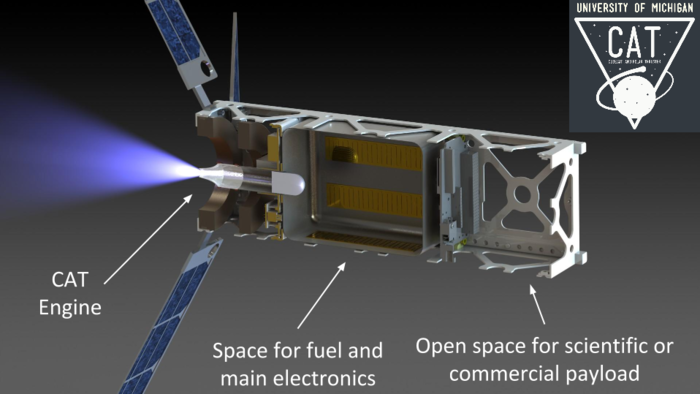Most CubeSat propulsion available today uses pressurized gas or monopropellant. While most of these require nearly no power to run, they have very low exhaust velocities. On the other end of the spectrum, most electric thrusters have excellent exhaust velocities, but are heavy, require a great deal of power, and provide very little thrust.
Our research into this mission first became serious when we discovered the Cubesat Ambipolar Thruster (CAT), which is designed to enable interplanetary CubeSat missions. Permanent magnets form a magnetic nozzle, and an RF antenna creates plasma.
CAT uses iodine as propellant, which has performance very close to that of xenon, and is cheaper and can be stored solid. Solid storage means that propellant tanks can be much smaller and do not have to hold pressure.
CAT provides about 100 mN/kW, as opposed to 10 from comparable ion thrusters, at about 1,000sec Isp, compared to 200 from monopropellant thrusters. However, while efficient enough to allow a CubeSat to get to Mars by itself(!), large solar arrays would need to be custom-made to provide enough power for the thruster to give enough thrust for practical operations at Mars, where solar intensity is 57%-71% lower than at Earth.

Credit: University of Michigan
Last November, we came across the ConstantQ hybrid electrostatic thruster, which is smaller, more efficient, and higher-performance than CAT for our purposes (CAT is still an excellent option for other applications!). The standard Model H system is comprised of four slightly angled thruster heads. The angle allows differential thrusting to provide torque, which is useful for desaturating reaction wheels (allowing flywheels to gradually slow down to nominal speeds without turning the spacecraft)

Credit: Fluid and Reason, LLC
The thruster generates plasma in pulses, about 2400 times per second. While listed as providing 1.25 mN of thrust per head, at 760sec Isp, tests have shown that it can provide 1.6 mN of thrust at 1,100sec Isp, which gives us a whopping 290.9 mN/kW at a better exhaust velocity than the CAT.
"Gas flow rate and the timing of these pulses drive the performance. When the flow rate goes too low, no plasma is generated. When too high, cold gas thrust increases but no plasma is formed. It's a very large flow range though. Likewise, when the spark frequency is too low, too little plasma is formed to combat the neutral gas and no plasma gets accelerated. When the spark frequency is too high, shock waves in the gas stop propellant flow and thrust stops. We have a variety of patent pending feedback mechanisms that let us control the operating point in real time." - Wes Faler
This increased thrust also means that 4 thruster heads give us enough acceleration, so we can use the off-the-shelf model of the thruster. The Model H masses 500 grams without propellant. Like the CAT, the ConstantQ uses iodine propellant which is stored solid, at a density of about 4 g/cm^3.
We expect the propulsion system to fit within 10 cm x 10 cm x 12 cm and carry slightly over two kilograms of propellant. Having a quarter of the initial spacecraft mass be propellant provides us with 3 km/s of delta-V, which we estimate is more than enough to complete our mission after Mars injection.
A solo mission to Mars from Geostationary Earth Orbit is feasible, but would require 50%-60% of the spacecraft's mass to be propellant, and would pose challenges that will be detailed in a future post.
Upcoming post: mission profiles!